The consumer price index increased more than expected in March, leading to higher inflation rates and potentially delaying any interest rate cuts by the Federal Reserve. The CPI rose 0.4% for the month, bringing the 12-month inflation rate to 3.5%. The core CPI, which excludes food and energy, also rose 0.4% on a monthly basis and 3.8% from a year ago. Stocks fell and Treasury yields rose after the report.
Shelter and energy costs were major drivers of the increase in the all-items index. Energy costs rose 1.1% while shelter costs increased by 0.4% on the month and 5.7% from a year ago. Food prices only increased by 0.1% on the month, with some categories experiencing larger gains such as meat, fish, poultry, and eggs, which climbed 0.9%. Used vehicle prices fell 1.1% and medical care services prices rose 0.6%.
Real average hourly earnings were flat on the month and increased by only 0.6% over the past year, which is bad news for workers. The Federal Reserve has been cautious about cutting interest rates, as they have not seen enough evidence that inflation is moving towards their 2% annual goal. Markets had expected rate cuts to start in June, but after the report, expectations were shifted to September.
With inflation showing signs of stickiness, the Fed is likely to continue its patient approach to monetary policy. Services inflation, excluding energy, increased by 0.5% in March and was at a 5.4% annual rate, which is inconsistent with the Fed’s target. Fed officials have expressed skepticism about lowering rates, with some suggesting only one cut may happen this year, possibly in the fourth quarter.
The March report confirmed fears that inflation is higher than expected, which may lead to further delays in rate cuts. Markets and investors were expecting rate cuts to start in June but have now shifted expectations to September. The Fed continues to monitor inflation levels and will release more insight into their monetary policy decisions in the coming days. Multiple Fed officials have shown caution about lowering rates, with some suggesting that an increase may even be necessary if the data does not cooperate.


